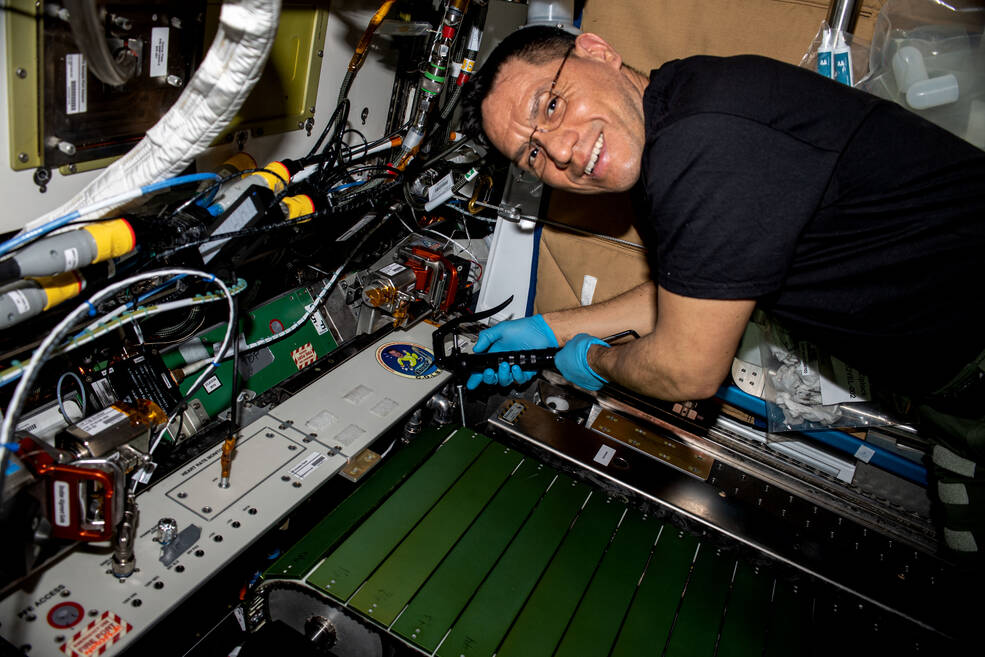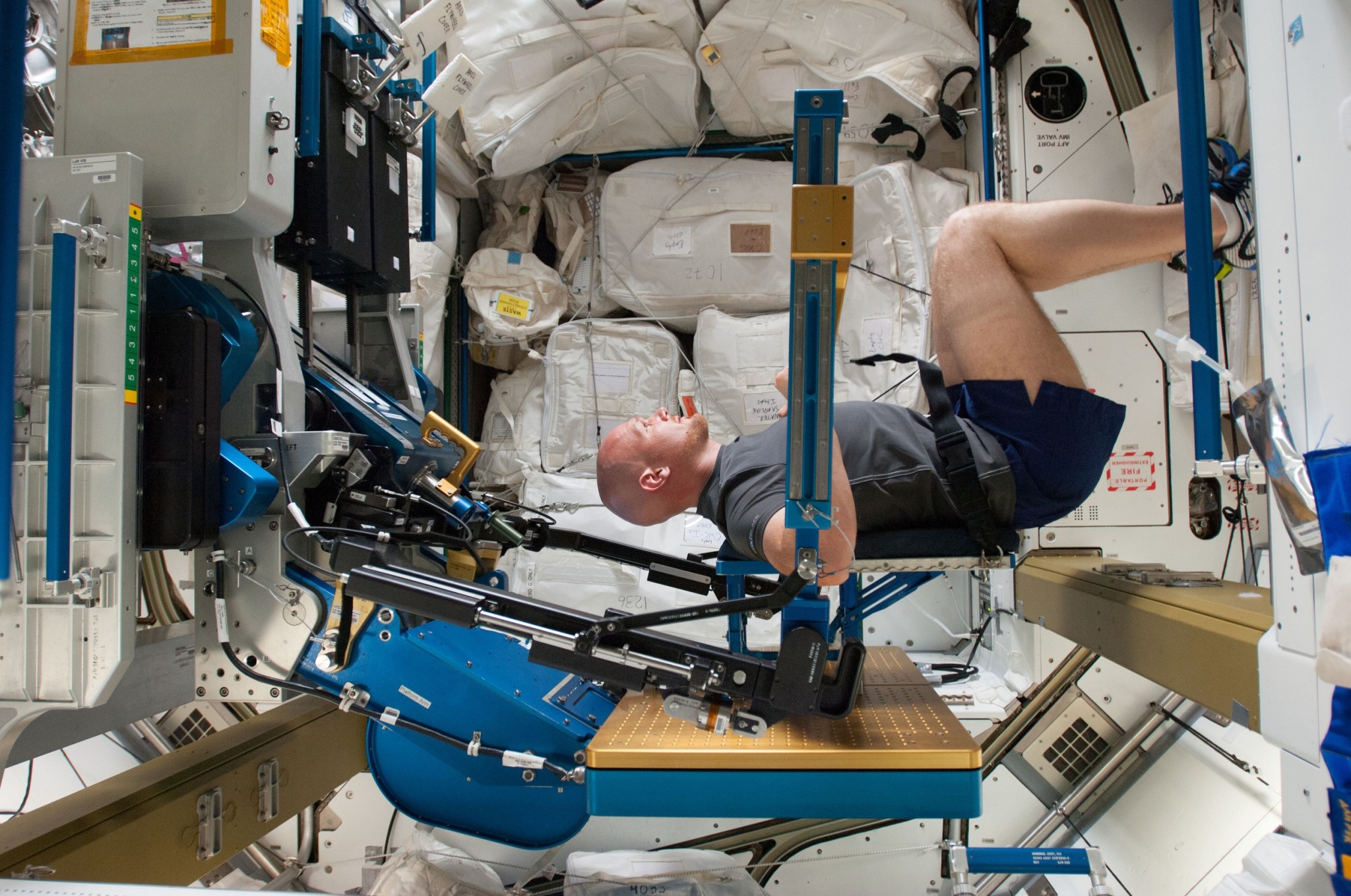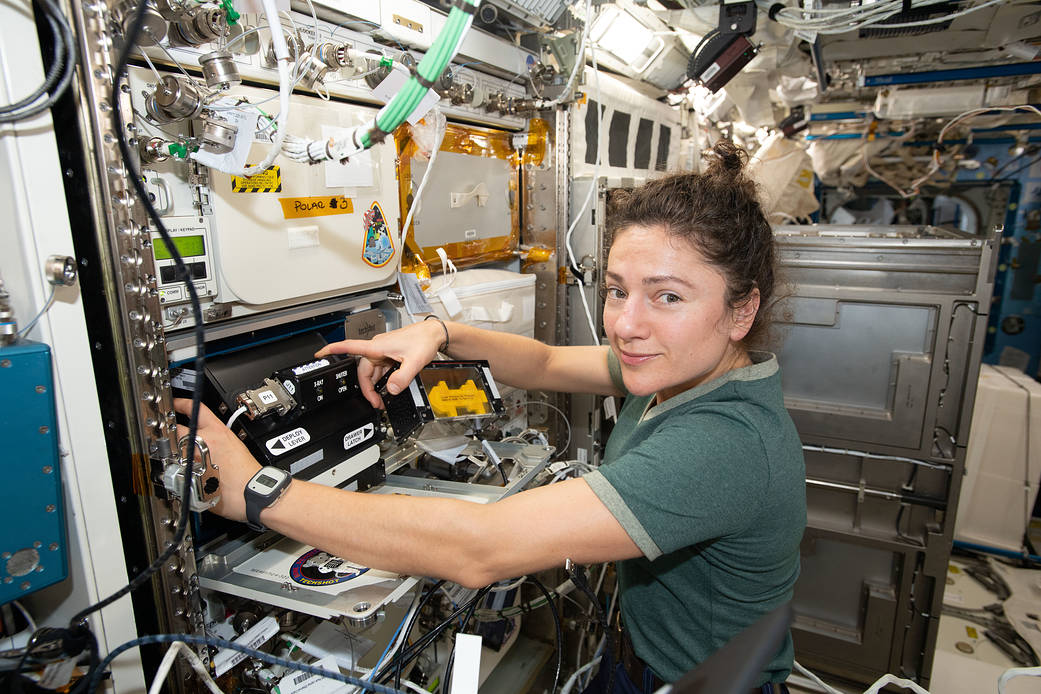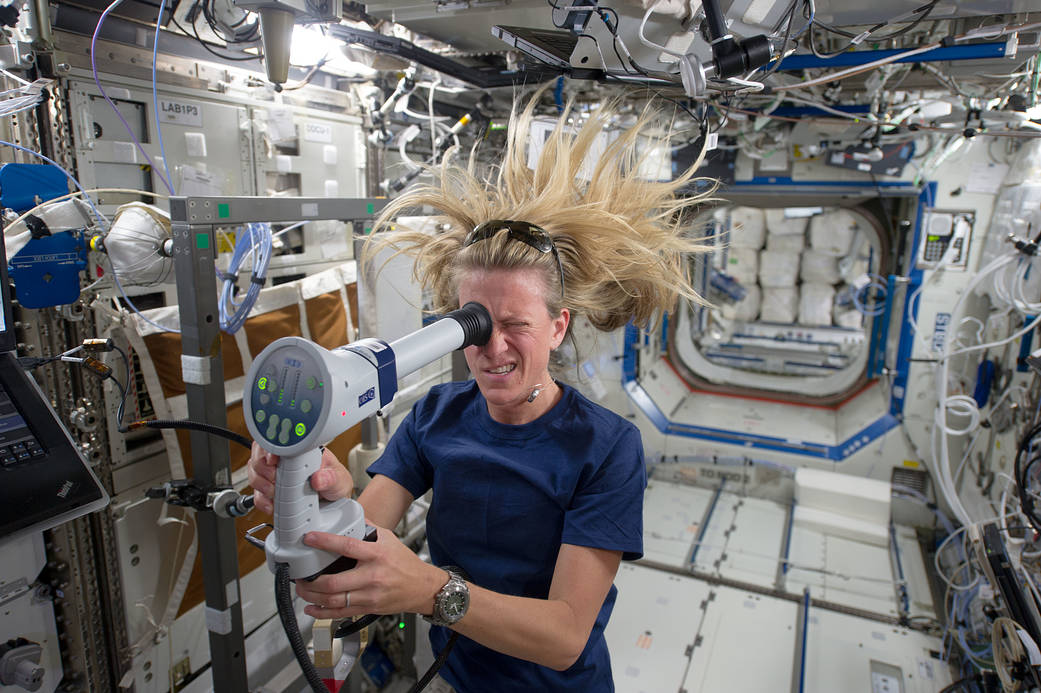In microgravity, without the continuous load of Earth’s gravity, the tissues that make up bones reshape themselves. Bone cells readjust their behaviors—the cells that build new bone slow down, while the cells that break down old or damaged bone tissue keep operating at their normal pace so that breakdown outpaces growth, producing weaker and more brittle bones. For every month in space, astronauts’ weight-bearing bones become roughly 1% less dense if they don’t take precautions to counter this loss. Muscles, usually activated by simply moving around on Earth, also weaken because they no longer need to work as hard. This loss of bone and muscle is called atrophy.
Atrophy has serious implications for astronaut health. On Earth, muscle and bone loss or atrophy also occur from normal aging, sedentary lifestyles, and illnesses. This may cause serious health issues from injuries due to falls, osteoporosis, or many other medical problems.
While researchers understand broad causes of atrophy, they continue to investigate the fundamental mechanisms and contributing factors of microgravity-induced muscle and bone atrophy. Much research focuses on determining the right combination of diet, exercise, and medication to keep astronauts healthy during missions and when they return to Earth or set foot on the Moon or Mars.
Exercise & Forces
Each astronaut aboard the space station engages the muscles, bones, and other connective tissues that comprise their musculoskeletal systems using Earth-like exercise regimens. Crews exercise for an average of two hours a day.
Astronauts have biked on stationary bicycles and run on treadmills in space for decades. One of the first missions on the space station flew TVIS, a treadmill with a harness to keep the user tethered to the machine and add some gravity-like force.1 A current piece of equipment called ARED allows astronauts to mimic weightlifting in microgravity.
Unfortunately, these machines are too large to bring aboard a spacecraft for long duration space flight where room is at a premium. So scientists are curious: Could exercises using minimal or no equipment could provide adequate physical activity while taking up less room?
One study in particular aims to find out. For the Zero T2 experiment, some astronauts do not use the treadmill and instead simply perform aerobic and resistance exercises. Researchers plan to compare their muscle performance and recovery to their crewmates who did use the treadmill.
The motivation to exercise is a major hurdle both on Earth and on the space station. Two hours or more of exercise a day is a large chunk of time! VR for Exercise focuses on developing a virtual reality environment astronauts can pedal through while on the station’s exercise bicycle. It’s more than just a different view—creating an immersive experience helps astronauts enjoy their time exercising.
In addition to testing the exercise regime itself, researchers want to understand how the body experiences exercise in microgravity. Full-body exercise affects the entire musculoskeletal system. ARED Kinematics analyzes how muscle strain, bone stress, and other internal factors affect the body while exercising in microgravity. Measuring the body during space workouts can help scientists understand how astronauts need to adapt exercises in microgravity to preserve and optimize their health during long duration spaceflight missions. Researchers found that pre-flight exercise training improves performance on station, just as pre-season training helps athletes in later competition. 2 The investigation aims to determine optimal exercise programs to prepare astronauts before a mission, limit the effects of microgravity during a mission, and enable safe and rapid recovery postflight.2
The search for treatments for bone atrophy in space overlaps with research on bone loss associated with osteoporosis on Earth. Some experiments, like Vertebral Strength, capture detailed scans of astronauts’ bones and muscles supporting the vertebral column before and after flight, providing researchers with information about overall musculoskeletal strength.
Drugs used to prevent bone loss on Earth, such as myostatin inhibitors, also may successfully prevent bone and muscle loss in both astronauts and animal models in space. Rodent Research 19 (RR-19) tested this drug during spaceflight.3 Developing drugs to treat bone loss could benefit people on Earth as well as provide countermeasures for those on long-duration space missions.
Tissue chips are small devices that imitate complex functions of specific tissues and organs. Rather than bringing a whole organ to study in space, researchers can send a small sample in a handheld device. One tissue chip experiment, Human Muscle-on-Chip, used a 3D model of muscle fibers created from muscle cells of young and older adults to study muscle function changes in microgravity. Electrical pulses cause the tissue to contract, just like the muscles in our bodies when we use them. Researchers found decreased expression of genes related to muscle growth and metabolism in muscle cells exposed to space, with differences based on the age of the individuals that the tissue samples came from.4
Understanding how to prevent and treat muscle atrophy and bone loss is particularly important as NASA plans missions to the Moon and Mars. Once they arrive, astronauts may need to perform strenuous activity in partial gravity after a long time in near weightlessness.
CIPHER is an integrated experiment measuring psychological and physiological changes—including bone and muscle loss – in crew members on missions ranging in length from a few weeks to one year. As NASA sets goals or longer missions deeper into space, scientists want to know: Do long missions change astronauts’ physical bodies more than shorter missions? Do changes to certain systems plateau after a certain amount of time in space? Do any changes feed back to affect different biological systems? NASA needs such data to best prepare astronauts to achieve agency exploration goals.
Through CIPHER, NASA can conduct the same research over missions of different durations. This allows scientists to extrapolate to multi-year missions, such as a three-year round trip to Mars. Findings could be key to developing protective strategies and safeguarding crew members for exploration missions to the Moon and Mars.
Studying bone and muscle loss aboard the space station is advancing the development of strategies that keep space travelers safe and treatments for people on Earth with disease-related and age-related bone and muscle atrophy.
Andrea Lloyd
International Space Station Research Communications Team
Johnson Space Center
Resources for Additional Learning
Search this database of scientific experiments to learn more about those mentioned above.
Citations:
- Belyaev MY, Babkin EV, Ryabukha SB, Ryazantsev AV. Microperturbations on the International Space Station during physical exercises of the crew. Cosmic Research. 2011 April 16; 49(2): 160-174. DOI: 10.1134/S0010952511010011.
- Lambrecht G, Petersen N, Weerts G, Pruett CJ, Evetts SN, Stokes M, Hides JA. The role of physiotherapy in the European Space Agency strategy for preparation and reconditioning of astronauts before and after long duration space flight. Musculoskeletal Science & Practice. 2017 January; 27 Suppl 1S15-S22. DOI: 10.1016/j.math.2016.10.009
- Lee S, Lehar A, Meir JU, Koch C, Morgan A, Warren L, Rydzik R, Youngstrom DW, Chandok H, George J, Gogain J, Michaud M, Stoklasek TA, Liu Y, Germain-Lee EL. Targeting myostatin/activin A protects against skeletal muscle and bone loss during spaceflight. Proceedings of the National Academy of Sciences of the United States of America. 2020 September 2; 117(38): 23942-23951. DOI: 10.1073/pnas.2014716117. PMID: 32900939.
- Parafati M, Giza S, Shenoy T, Mojica-Santiago JA, Hopf M, Malany LK, Platt D, Moore I, Jacobs ZA, Kuehl P, Rexroat JT, Barnett G, Schmidt CE, McLamb WT, Clements TS, Coen P, Malany S. Human skeletal muscle tissue chip autonomous payload reveals changes in fiber type and metabolic gene expression due to spaceflight. npj Microgravity. 2023 September 15; 9(1): 77. DOI: 10.1038/s41526-023-00322-y.



































